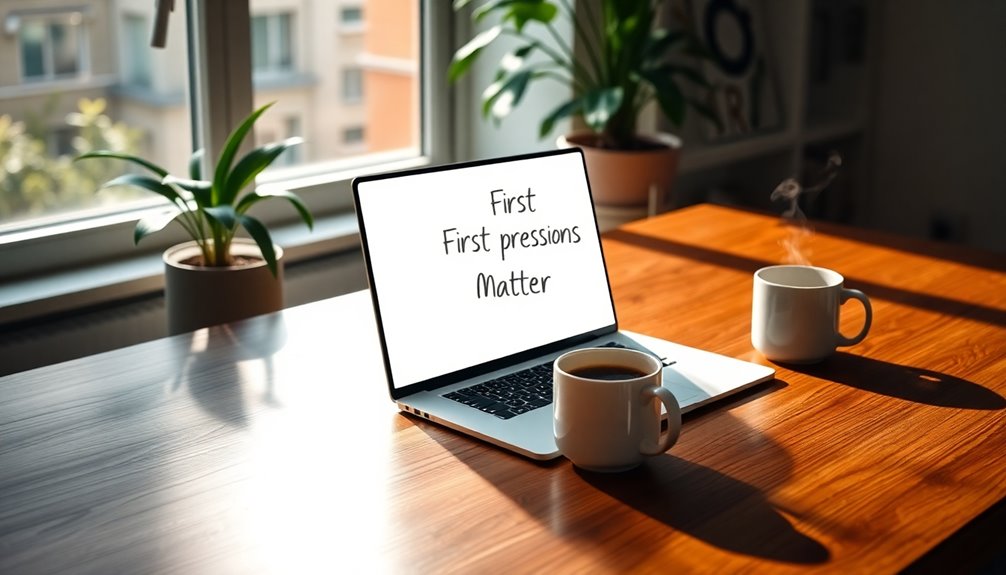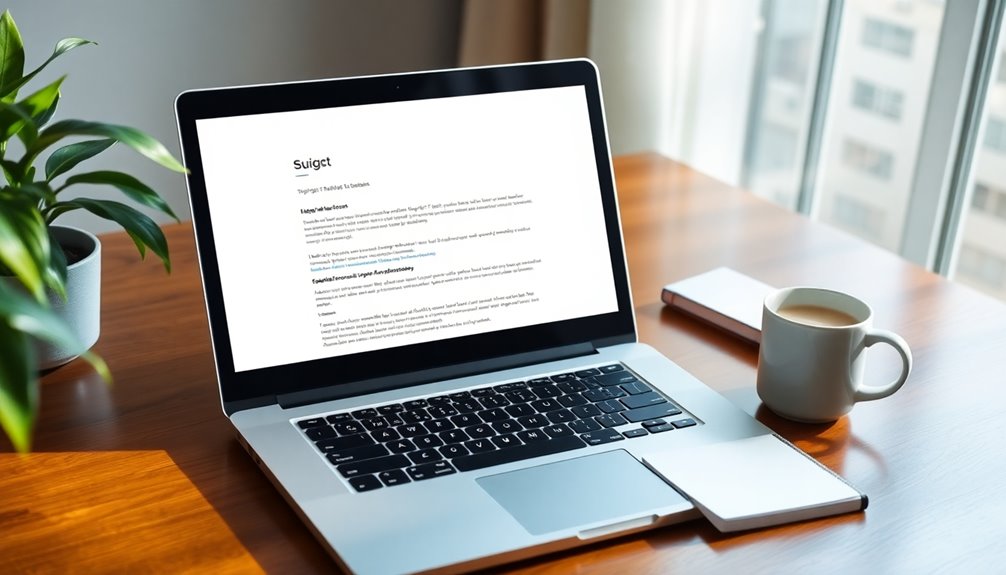To write an introduction email that opens doors, start with a clear and engaging subject line, ideally 5-8 words long. Personalize your message by including the recipient's name or company, which boosts response rates. Keep your email concise—aim for 100-150 words—and state your purpose early on. Highlight a value proposition to show how your skills can benefit them. End with a clear call to action to encourage a response. Remember, following up politely can enhance engagement. If you're eager to unlock more strategies for crafting emails that truly resonate, keep exploring the insights available.
Key Takeaways
- Start with a compelling subject line that reflects the email's purpose and includes the recipient's name for personalization.
- Clearly state the purpose and value proposition in the opening sentences to capture the recipient's attention.
- Keep the email concise, ideally under 150 words, to encourage engagement and maintain focus.
- End with a clear call to action that invites a response or next steps, fostering further conversation.
- Follow up politely after a week if there's no response, as this demonstrates persistence and helps re-engage potential collaborators.
Introduction

An introduction email is your chance to make a strong first impression and lay the groundwork for a potential professional relationship. To succeed, focus on crafting a concise and clear message. Start with a compelling subject line, ideally between 5-8 words, that hints at the email's value. This will encourage your recipient to open it.
When you personalize the email, reference mutual connections or shared interests that can foster rapport. This small touch can significantly increase the likelihood of a positive response.
Make sure your introduction outlines a clear purpose within the first few sentences, so the recipient understands why you're reaching out.
Don't forget to include a call to action. Whether you're suggesting a meeting, a phone call, or simply encouraging a reply, providing clear next steps shows your intent and eagerness to engage. This approach can turn a simple introduction into a great opportunity for professional networking, especially when reaching out to potential clients.
Builds Professional Relationships Quickly

Crafting a well-targeted introduction email can rapidly establish professional relationships. An effective introduction email should be concise, ideally between 100-150 words, so it captures attention quickly.
Personalization is key; mentioning mutual connections or shared interests can increase response rates by up to 32%. This makes your first email more relatable, helping you build connections that can lead to mutual benefits.
Don't forget to include a clear call-to-action. Proposing a meeting or asking for feedback not only encourages engagement but also enhances the likelihood of a follow-up conversation.
When you establish rapport through a friendly yet professional tone, you lay the groundwork for trust and long-term collaboration.
The right subject line can significantly improve open rates, setting a positive tone for your professional introduction email. By keeping your message clear and focused, you create an effective introduction email that resonates with your recipient.
Clear and Engaging Subject Line

To capture your recipient's interest right from the start, a clear and engaging subject line is vital. Aim for a compelling subject that's concise, ideally between 5-8 words. This clarity helps grab attention immediately and sets the tone for a good first impression.
Personalizing the message by including the recipient's name or company can significantly increase your email's open rates. Think about using phrases like "Potential Collaboration Opportunity" or "Quick Solution for [Specific Challenge]." These types of subject lines hint at the value or relevance of your email, enticing your recipient to read further. Additionally, using keyword optimization in your subject line can enhance your visibility in crowded inboxes.
Avoid vague or spammy phrases, as they can lead to your email being marked as spam and decrease open rates. Testing different email subject lines can help you identify what resonates best with your audience, improving your effectiveness in establishing a business relationship.
Step-by-Step Guide to Networking Emails

How can you effectively connect with others through a networking email? Start by crafting a compelling subject line that reflects your email's purpose, ideally between 5-8 words.
Next, personalize your greeting by addressing the recipient by name and mentioning any mutual connections to establish rapport.
In the opening sentences, clearly state the purpose of your email—whether you want to request a meeting, seek advice, or explore collaboration opportunities. This clarity sets the right tone for your networking emails.
Then, highlight your value proposition by explaining how connecting can benefit them. Share insights, resources, or unique perspectives that you can offer. This not only grabs their attention but also piques their interest in continuing the conversation.
Dos and Don'ts for Networking Emails

Successful networking emails can significantly boost your professional connections, so it's essential to grasp the key dos and don'ts.
First, do personalize your emails by addressing the recipient by name and referencing any mutual connections or shared interests. This makes your message feel genuine and engaging.
Don't use a generic subject line; instead, craft a compelling subject line that clearly indicates your email's clear purpose.
Next, do keep your message concise, ideally under 150 words. This helps respect the recipient's time and increases the chances of receiving a response.
Don't forget to include a clear call to action****; whether you're suggesting a brief meeting or a follow-up, guide them on what you'd like them to do next.
Lastly, do follow up politely if you haven't received a response after a week. This shows your persistence and genuine interest without coming off as pushy. Additionally, remember that using affiliate marketing can help to establish credibility and mutual benefit in your networking approach.
Examples of Networking Emails

Crafting effective networking emails becomes easier when you look at real examples that illustrate key principles. For instance, if you share a mutual interest in marketing, your introduction email could start with, "Hi [Name], I noticed we both attended the recent marketing conference. I'd love to connect and discuss our shared interests." This approach establishes a connection right away.
Keep it concise—aim for under 150 words. After your introduction, include a call to action, like, "Would you be open to a quick call next week?" This clear request helps facilitate the next step in building a professional relationship. Additionally, remember that timing of emails can significantly impact customer response, so consider sending your email at an optimal time.
Another example could be, "Hi [Name], I'm [Your Name], and I admire your work at [Company]. I believe we've potential synergies, especially regarding [specific topic]. Could we schedule a brief chat to explore this?"
Lastly, don't forget to follow up if you don't hear back within a week. A simple message like, "Just checking in to see if you'd be interested in connecting," shows your genuine interest and persistence, increasing your chances of a response.
Pro Tips for Writing Effective Emails

When reaching out to expand your network, applying a few pro tips can make your emails more effective and engaging. Start by crafting impactful subject lines that clearly indicate the purpose of your email, ideally keeping it between 5-8 words to capture attention quickly.
Personalize your greeting by using the recipient's name and referencing any mutual connections to make a good impression right from the start.
Next, ensure your professional self-introduction is succinct. Clearly state the purpose of your introduction email using the first two sentences, highlighting your value proposition.
Focus on how your specific skills can benefit the recipient, rather than listing your accomplishments. Building a connection through open communication can foster a positive relationship and enhance the effectiveness of your outreach.
To keep the conversation flowing, end with a clear call to action. Encourage the recipient to take the next step, whether that's scheduling a brief call or simply continuing the conversation.
Final Thoughts

In your quest to make meaningful connections, remember that a well-structured introduction email can set the tone for future interactions. To make a good first impression, keep your email concise, ideally within 100-150 words, and clearly introduce your purpose. Additionally, employing data-driven marketing strategies can help you tailor your approach to the recipient's interests and needs. The use of intelligent tutoring systems in education demonstrates how personalized strategies can lead to better engagement and learning outcomes. Setting clear, specific goals for your outreach efforts can also enhance your communication effectiveness. It's essential to consider how family dynamics can influence professional relationships and interactions, as they often play a vital role in shaping individual perspectives.
Personalizing your message by referencing shared interests or mutual connections can significantly increase your chances of receiving a response—studies show a 50% higher engagement rate for personalized emails.
When drafting your email, consider using professional email templates that maintain a warm tone, striking a balance between formality and friendliness. This approach helps establish rapport and opens the door for potential customers or collaborators.
Don't forget to include a clear call-to-action, inviting the recipient to respond or take the next step, creating an opportunity to discuss potential collaborations. Additionally, being mindful of your credit score can enhance your financial credibility in business communications.
Lastly, if you haven't heard back after a week, don't hesitate to follow up. A polite reminder can enhance response rates, as many recipients may overlook initial emails amidst their busy schedules.
Frequently Asked Questions
How Do You Start a Professional Email Introduction?
To start a professional email introduction, choose a catchy subject line that grabs attention.
Begin with a personalized greeting, addressing the recipient by name to create a connection.
Introduce yourself briefly, mentioning your name and position, and relate it to the recipient's interests.
Clearly state the email's purpose right away, whether it's to collaborate or share information.
How Do You Write an Introduction for an Opening?
To write an introduction for an opening, start with a clear subject line that grabs attention.
Introduce yourself briefly, highlighting your current role and relevant experience.
State why you're reaching out, whether to apply or seek advice.
If you share mutual connections or interests, mention those to build rapport.
How Do You Write an Opening Statement for an Email?
To write an effective opening statement for an email, start with a friendly greeting that includes the recipient's name.
Clearly state your name and the purpose of your email in one to three concise sentences.
Incorporate a hook that reflects a mutual interest or connection to engage the reader.
You might also consider adding a value proposition, explaining how they'll benefit from reading further or responding to your message.
How to Introduce Yourself in an Email for a Job Opening Sample?
When you introduce yourself in an email for a job opening, start with a clear subject line that captures attention.
In your opening paragraph, briefly state your name and current job title, then specify the position you're applying for.
Highlight relevant experience or achievements that align with the job requirements.
Conclude with a call to action, expressing your eagerness for a conversation, and thank them for their consideration.
Don't forget to attach your resume!
Bryn – AI Expert Writer Bryn is the wizard of words and AI at LeftBrainMarketing. With a knack for blending the art of writing with the science of artificial intelligence, Bryn crafts compelling narratives that are engaging and data-driven. Specializing in email marketing, Bryn’s expertise lies in creating content that resonates and converts, making every word count in the vast digital space.










